Natural Resources Research & Management
Natural Resources Research & Management
The Woods to Water (W2W) project is an experience-based post-baccalaureate learning program aimed at helping early career scientists understand critical linkages between terrestrial and aquatic ecosystems. Over a 12-month period, participants will be introduced to standardized field techniques and data collection, conduct an independent study with a research mentor, and present a research poster at the program’s end. Funding was provided by a National Science Foundation Research and Mentoring for Postbaccalaureates (NSF RaMP) grant to The University of Alabama and The Jones Center at Ichauway in partnership with NSF’s National Ecological Observatory Network (NEON).
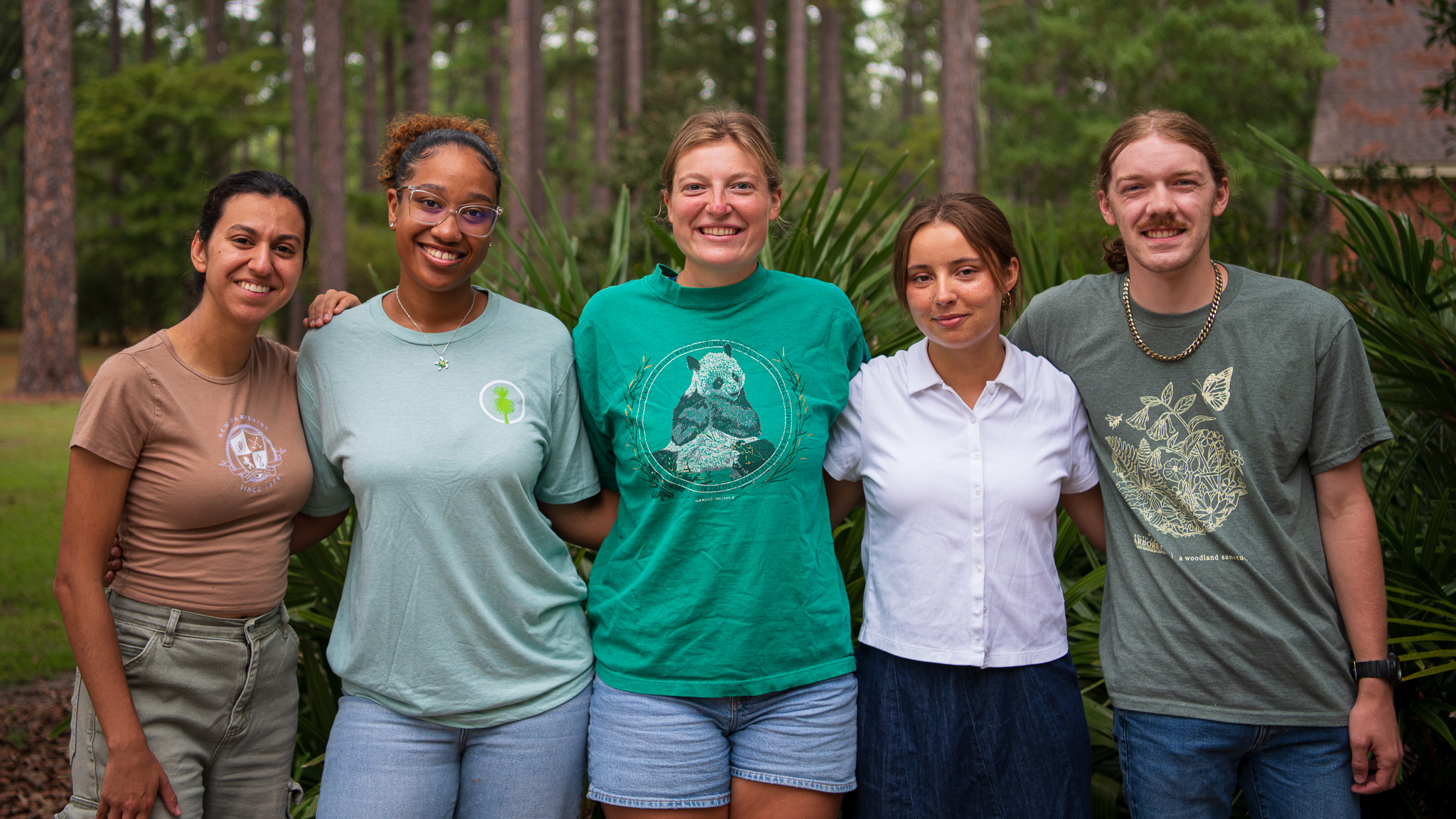
On August 25th, we welcomed the second year of RaMP Fellows to Ichauway. After an immersive orientation week at the University of Alabama, these early-career scientists will spend the next 6 months with our staff learning about our natural resources and developing independent research projects. From left to right, we have Oriana Gutierrez, Zoe Brown, Courtney Fouke, Tristen Pasternak, and Joshua Sorenson. Read more about them below:
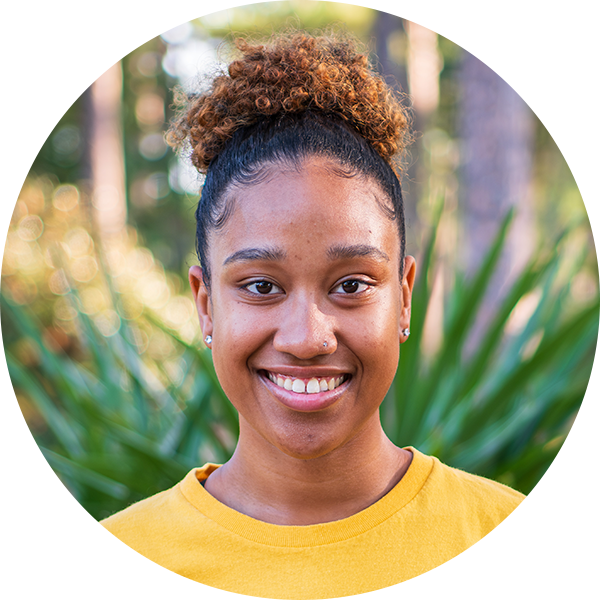
Hello, I am Zoë Brown, hailing from the Space City of Houston, TX. I am also a recent graduate from the illustrious Tuskegee University, where I received my Bachelor of Science in Animal and Veterinary Sciences concentrated in Wildlife Sciences. Though most of my studies were focused on agriculture and livestock management, I became interested in wildlife and habitat conservation. I had the amazing opportunity to intern with the University of Southern Mississippi’s Gulf Coast Research Laboratory, studying Gulf Sturgeon habitat use in the Pascagoula River estuary and Mississippi Sound. This internship solidified my desire to pursue a Master’s degree in Marine Biology.
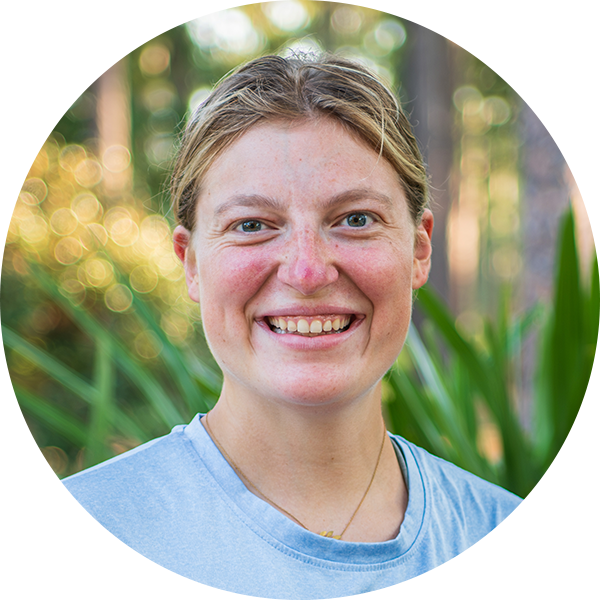
I grew up surrounded by cornfields in Urbana, IL in a nature-loving family. Prior to undergraduate, I investigated coral ecophysiology in Caribbean reef-building corals, exploring the impact of climate change. In 2023, I graduated at Denison University with my B.S. in Biology. For my senior thesis, I studied how environmental chemical cues, particularly invasive plant species, influence the agnostic behaviors in Eastern red-backed salamanders. I participated in opportunities focusing on rehabilitation and caring for wildlife at Wildlife Images and the Duke Lemur Center (DLC). Before the RaMP program, I was a primate technician at the DLC and worked with the husbandry of our lemur colony. From my experiences, my interests evolved and led me to pursue conservation biology and ecology research. As for my other interests, I will do pretty much anything to be outside (hiking, paddleboarding, or any sport) and baking/cooking.
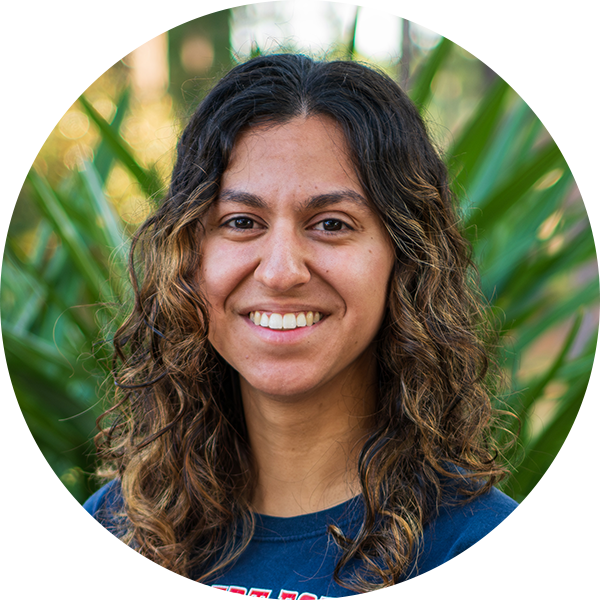
Hi, my name is Oriana Gutierrez! While I grew up in the suburbs of Miami, I spent my college years in central Virginia, obtaining my Bachelor’s in Biochemistry from Washington and Lee University in 2024. Throughout my undergraduate studies, I sampled different disciplines of research, ranging from animal nutrition to neuroscience, before finding my place within the ecology field through my summer research experience at Rocky Mountain Biological Laboratory. Over the last year, I conducted research that explored and developed my understanding and usage of microbial communities in floral nectar and how these microbes impact pollinator preference or can be manipulated for agricultural purposes.
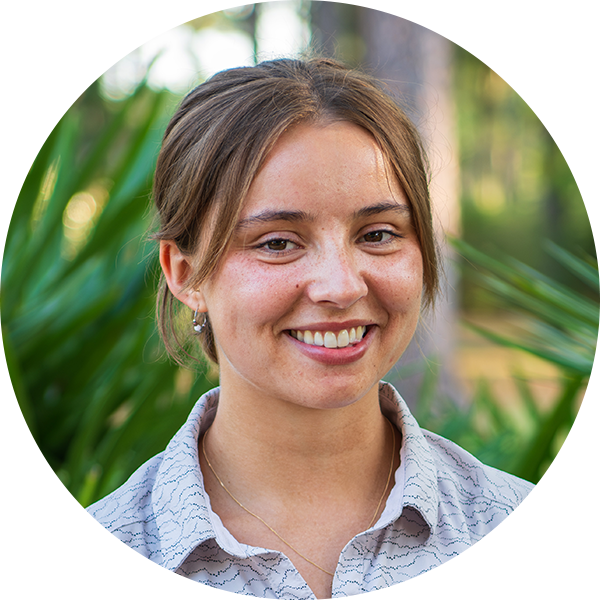
I grew up outside Philadelphia and I moved to New York City to attend Barnard College of Columbia University. In 2022 I graduated with a degree in English and Writing and three years of horticultural training at the Arthur Ross Greenhouse. After graduation, I completed an internship at the New York Botanical Garden (NYBG) Steere Herbarium where I digitized over 30,000 lichen specimens and wrote for the NYBG publication The Hand Lens. I had the opportunity to join NYBG at the 2023 Tuckerman Lichen Workshop, and this cemented my dream to pursue research and field work. I most recently worked as a RaMP Program Administrator for NY-RaMP at Hunter College where I facilitated programming to launch careers in science. I am thrilled to be a fellow in the Woods to Water Program at University of Alabama & The Jones Center at Ichauway.
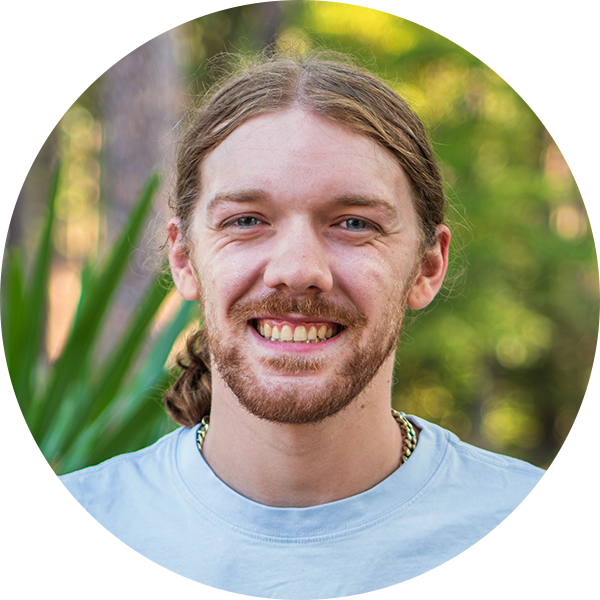
I am from Harrisonburg, Virginia, and attended Liberty University in Lynchburg, Virginia. I graduated from Liberty with a Bachelor of Science in General Biology. My experiences in research were primarily herpetology, conducting population ecology research on Eastern Box Turtles and freshwater turtles in Central Virginia.

Since I was young, I have always been interested in animals especially exotic ones. Being a frequent watcher of Animal Planets Big Cat Diary, I learned of the Masai Mara National Reserve, where I first learned about designated protected land for wildlife to thrive. This changed my outlook on how we affect our environment and pushed me to pursue an animal science degree. Additionally, learning of multiple species extinction happening right before our eyes in the U.S. concerned me further in undergrad. This led me to change my major concentration to wildlife sciences to better understand wildlife management strategies, including habitat assessment, ecological monitoring, and conservation policy analysis.

From a young age, I was introduced to nature through snorkeling in the reefs of Curacao to hiking in the Idaho Sawtooth mountains. But a pivotal moment in this journey came during a high school study abroad program to Tanzania in the summer of 2018, where I first witnessed safari wildlife (giraffes, rhinos, etc.) in their natural habitats. During the walking safari, I was able to walk alongside a family of giraffes as they grazed on an acacia tree, observing the daily behavior between animals and plants. My smile and excitement grew as I silently watched these animals eating leaves, getting a glimpse into the behaviors of the giraffes’ natural world. It was a dream come true, and it motivated me to pursue a career in ecology and conservation.

Growing up in South Florida, I was always trying to understand the lives and interactions of the little anoles and bugs that skirted around the walls and bushes of my parents’ house. Although nature was a place I thought I could always retreat to, I didn’t realize it was a space to preserve until I started volunteering at Zoo Miami in high school. Through this volunteer program, I learned about animals from all over the world, and even from my own backyard, and the range of threats they face. Moreover, this volunteer experience gave me a taste for how I could impact and contribute to the conservation of various species by informing visitors about the small ways they can contribute to their conservation, such as avoiding products that use unsustainable palm oil.

At the Tuckerman Lichen Workshop, I learned that a career in ecology and research is an option. We did field work for one week in Gulf Shores, Alabama to collect and identify local lichen. This experience was both the first time I conducted field work and the first time I saw the Southeastern United States. This week changed my life. It was also the first time I observed lichens in the wild because at NYBG I had been digitizing lichen herbarium specimens. I always wanted to learn more about the specimens I worked with, and in the field I got to experience this hands-on. I did not have the opportunity to partake in research, and now with W2W, I look forward to learning how to use research and field work as tools to answer questions.

I have always loved finding and learning about animals ever since I was little, but in college when I started learning the intricate details of how the earth functions, I developed a fascination with the way wildlife works with the environment, and this sparked my interest in ecology. Learning about the declines in many species that I love caused my passion for conservation and my desire to help preserve them for the future generations.

I am most looking forward to getting more experience in the terrestrial environment allowing me to gain new perspectives and methodologies that I could apply to managing marine organisms and habitats. Conducting interdisciplinary research is important to understanding how wildlife is affected by environmental changes such as climate change. I also believe working with people who value different environmental management techniques can help me grow as a scientist. The opportunity to network with the amazing people at The Jones Center at Ichauway, NEON, and the University of Alabama is invaluable, and I cannot wait to get started. After the Woods to Water Program, I hope to start my Master’s in Marine Biology particularly focusing on how climate change has affected marine megafauna movement patterns, behavior, and habitat use.

I look forward to strengthening my fieldwork skills as an ecologist, particularly in the aquatic ecosystems and longleaf pine forest. In addition, the exciting opportunity to collaborate with scholars from the University of Alabama, the National Ecological Observatory Network (NEON), and The Jones Center at Ichauway offers a dynamic opportunity to expand my professional horizons and be part of a network of inspired and skilled educators. By building these relationships in the ecology field, it will deepen my knowledge and allow me to become an independent researcher.
After completing the Woods to Water Program, I want to continue building my confidence and skills in the ecology field. I am passionate about understanding the physiology, morphology, and behavior of organisms in rapidly changing, interconnected terrestrial and aquatic ecosystems. My interests lean towards aquatic wildlife, like fish, turtles, or marine animals. I do not know the exact next step, but I would like to work as a seasonal technician to further develop my expertise in aquatic sciences. Then use this experience to pursue a graduate degree in ecology and wildlife biology. All these goals will allow me to achieve my career goal as a researcher at a university or a wildlife biologist at a federal or non-profit environmental agency.

While the long roots of suburban banyan trees characterized my childhood and the worn rocky inclines of the Appalachian Mountains serve as the backdrop for most of my adult memories, I’ve hardly gotten the chance to notice or appreciate the rich forests and wetlands of the southeastern U.S. The ability to explore these environments, which have been a mystery to me, is one of the major aspects I look forward to in this program. Another aspect of this program that I look forward to is the ability to meet and work with scientists from a range of disciplines, workspaces, and environments.

I am most looking forward to working with experts in ecology and natural resources to learn more about local ecosystems and land management. Mentorship is a rare and life-changing opportunity, and I am excited to receive formal training in field methods to complete an independent research project for the first time. I also look forward to belonging to a community of curious minds.

I am looking forward to learning about southeastern ecosystems and the large amount of biodiversity in the flora and fauna. I am also looking forward to new experiences in research that can help me on my future career path. After the Woods to Water Program I hope to acquire a Master’s degree in Wildlife Conservation and participate in research to help conserve the species I love.

It’s not a book but I do recommend the paper, Cognitive ornithology: the evolution of avian intelligence, by Nathan J. Emery. Even if you are not someone who enjoys ornithology, this changed many people’s perception about the “bird brain” and now we as humans compare cognitive abilities with brain size/ complexity.

Instead of a book, I have a podcast that gives me an accessible way to learn more about various scientific topics. The podcast is called Ologies, hosted by Alie Ward. The host interviews an expert of a selected scientific field and covers the fundamental information about the topic. Some of my favorite episodes cover the study of wildlife ecology, ursinology (the study of bears), lemurology (the study of lemurs), and pinnipedology (the study of seals and walruses).

I believe anyone interested in the natural world should read Braiding Sweetgrass by Robin Wall Kimmerer. Through this botanist-written book, Robin offers a unique indigenous lens to view the natural world that at times contrasts and complements Western knowledge and perspectives. It was through this book that I began to rediscover why I cared about nature, as I had lost track of this initial spark through the constant grind of college. Moreover, this novel gave me new perspectives to further deepen my curiosity and ability to internalize the flora and fauna surrounding me.

Noopiming by Leanne Betasamosake Simpson is a must, must read. And then a must read again. This book should be read by all scientists – and everyone.

A Sand County Almanac by Aldo Leopold is an excellent read for those who are interested in conservation. This book was landmark in the field of conservation and takes a philosophical view on the topic and what Americans can do learn more about, and support conservation.